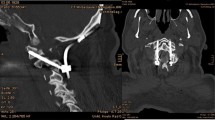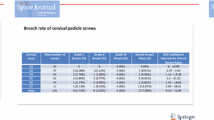Abstract
Cervical pedicle screw is thought to be the most stable instrumentation for reconstructive surgery of the cervical spine. However, because of the unresolved and inherent risk of neurovascular injuries due to screw perforation, it remains not widespread nowadays despite the excellent biomechanical property. Fifty-two consecutive cases having undergone spinal reconstruction using cervical pedicle screw were investigated. There were 24 females and 28 males. The mean follow-up period was 53 months. Those patients were stratified into three groups according to the period of screw insertion. A total of 280 screws were inserted. Ninety-two screws in 19 cases, 100 screws in 18 cases and 88 screws in 15 cases were inserted in the earlier, the middle and the later periods, respectively. Clinical results including complications were recorded in all cases. Screw perforations were evaluated in both plain X-ray and CT. Screw perforations occurred in 11 (12.0%), 7 (7.0%) and 1 (1.1%) screws in each period. There were no complications, such as infection, neurological deterioration and neurovascular injury directly related to screw insertion. The learning curve showed a significant improvement especially in the later period. However, the perforation rates in both the earlier and middle periods must not be underestimated. Surgeons with less experience must insert cervical pedicle screws with the assistance of a senior surgeon to avoid lethal complications.





Similar content being viewed by others
References
Abumi K, Itoh H, Taneichi H, Kaneda K (1994) Transpedicular screw fixation for traumatic lesions of the middle and lower cervical spine: description of the techniques and preliminary report. J Spinal Disord 7:19–28. doi:10.1097/00002517-199407010-00003
Abumi K, Kaneda K (1997) Pedicle screw fixation for nontraumatic lesions of the cervical spine. Spine 22:1853–1863. doi:10.1097/00007632-199708150-00010
Abumi K, Kaneda K, Shono Y, Fujiya M (1999) One-stage posterior decompression and reconstruction of the cervical spine by using pedicle screw fixation systems. J Neurosurg 90(Suppl 1):19–26
Abumi K, Takada T, Shono Y, Kaneda K, Fujiya M (1999) Posterior occipitocervical reconstruction using cervical pedicle screws and plate-rod systems. Spine 24:1425–1434. doi:10.1097/00007632-199907150-00007
Abumi K, Shono Y, Taneichi H, Ito M, Kaneda K (1999) Correction of cervical kyphosis using pedicle screw fixation systems. Spine 24:2389–2396. doi:10.1097/00007632-199911150-00017
Abumi K, Shono Y, Kotani Y, Kaneda K (2000) Indirect posterior reduction and fusion of the traumatic herniated disc by using a cervical pedicle screw system. J Neurosurg 92(Suppl 1):30–37
Abumi K, Shono Y, Ito M, Taneichi H, Kotani Y, Kaneda K (2000) Complications of pedicle screw fixation in reconstructive surgery of the cervical spine. Spine 25:962–969. doi:10.1097/00007632-200004150-00011
Abumi K, Ito M, Kaneda K (2000) Surgical treatment of cervical destructive spondyloarthropathy (DSA). Spine 25:2899–2905. doi:10.1097/00007632-200011150-00011
Cha SH, Kim C, Choi BK, Kim HJ, Baek SY (2007) C-arm assessment of cervical pedicle screw: screw coaxial fluoroscopy and oblique view. Spine 32:1721–1727. doi:10.1097/BRS.0b013e3180b9f29b
Chazono M, Soshi S, Inoue T, Kida Y, Ushiku C (2007) Anatomical considerations for cervical pedicle screw insertion: the use of multiplanar computerized tomography reconstruction measurements. J Neurosurg Spine 4:472–477. doi:10.3171/spi.2006.4.6.472
Dickerman RD, Reynolds AS, Stevens Q, Zigler J (2007) Cervical pedicle screws vs. lateral mass screws: uniplanar fatigue analysis and residual pullout strengths. Spine J 7:384. doi:10.1016/j.spinee.2007.01.002
Djurasovic M, Dimar JR 2nd, Glassman SD, Edmonds HL, Carreon LY (2005) A prospective analysis of intraoperative electromyographic monitoring of posterior cervical screw fixation. J Spinal Disord Tech 18:515–518. doi:10.1097/01.bsd.0000173315.06025.c6
Ebraheim NA, Xu R, Knight T, Yeasting RA (1997) Morphometric evaluation of lower cervical pedicle and its projection. Spine 22:1–6. doi:10.1097/00007632-199701010-00001
Ito H, Neo M, Yoshida M, Fujibayashi S, Yoshitomi H, Nakamura T (2007) Efficacy of computer-assisted pedicle screw insertion for cervical instability in RA patients. Rheumatol Int 27:567–574. doi:10.1007/s00296-006-0256-7
Johnston TL, Karaikovic EE, Lautenschlager EP, Marcu D (2006) Cervical pedicle screws vs lateral mass screws: uniplanar fatigue analysis and residual pullout strengths. Spine J 6:667–672. doi:10.1016/j.spinee.2006.03.019
Jones EL, Heller JG, Silcox DH, Hutton WC (1997) Cervical pedicle screws versus lateral mass screws: anatomic feasibility and biomechanical comparison. Spine 22:977–982. doi:10.1097/00007632-199705010-00009
Karaikovic EE, Daubs MD, Madsen RW, Gaines RW Jr (1997) Morphologic characteristics of human cervical pedicles. Spine 22:493–500. doi:10.1097/00007632-199703010-00005
Karaikovic EE, Kunakornsawat S, Daubs MD, Madsen TW, Gaines RW Jr (2000) Surgical anatomy of the cervical pedicles: landmarks for posterior cervical pedicle entrance localization. J Spinal Disord 13:63–72. doi:10.1097/00002517-200002000-00013
Karaikovic EE, Yingsakmongkol W, Gaines RW Jr (2001) Accuracy of cervical pedicle screw placement using the funnel technique. Spine 26:2456–2462. doi:10.1097/00007632-200111150-00012
Kast E, Mohr K, Richter HP, Börm W (2006) Complications of transpedicular screw fixation in the cervical spine. Eur Spine J 15:327–334. doi:10.1007/s00586-004-0861-7
Kim HS, Heller JG, Hudgins PA, Fountain JA (2003) The accuracy of computed tomography in assessing cervical pedicle screw placement. Spine 28:2441–2446. doi:10.1097/01.BRS.0000090830.94641.AE
Kim YJ, Lenke LG, Bridwell KH, Cho YS, Riew KD (2004) Free hand pedicle screw placement in the thoracic spine: is it safe? Spine 29:333–342. doi:10.1097/01.BRS.0000109983.12113.9B
Kotani Y, Cunningham BW, Abumi K, McAfee PC (1994) Biomechanical analysis of cervical stabilization systems: an assessment of transpedicular screw fixation in the cervical spine. Spine 19:2529–2539. doi:10.1097/00007632-199411001-00007
Kotani Y, Abumi K, Ito M, Minami A (2003) Improved accuracy of computer-assisted cervical pedicle screw insertion. J Neurosurg 99(Suppl 3):257–263
Kothe R, Rüther W, Schneider E, Linke B (2004) Biomechanical analysis of transpedicular screw fixation in the subaxial cervical spine. Spine 29:1869–1875. doi:10.1097/01.brs.0000137287.67388.0b
Kowalski JM, Ludwig SC, Hutton WC, Heller JG (2000) Cervical spine pedicle screws: a biomechanical comparison of two insertion techniques. Spine 25:2865–2867. doi:10.1097/00007632-200011150-00005
Ludwig SC, Kramer DL, Balderston RA, Vaccaro AR, Foley KF, Albert TJ (2000) Placement of pedicle screws in the human cadaveric cervical spine: comparative accuracy of three techniques. Spine 25:1655–1667. doi:10.1097/00007632-200007010-00009
Ludwig SC, Kowalski JM, Edwards CC 2nd, Heller JG (2000) Cervical pedicle screws: comparative accuracy of two insertion techniques. Spine 25:2675–2781. doi:10.1097/00007632-200010150-00022
Miller RM, Ebraheim NA, Xu R, Yeasting RA (1996) Anatomic consideration of transpedicular screw placement in the cervical spine: an analysis of two approaches. Spine 21:2317–2322. doi:10.1097/00007632-199610150-00003
Neo M, Sakamoto T, Fujibayashi S, Nakamura T (2005) The clinical risk of vertebral artery injury from cervical pedicle screws inserted in degenerative vertebrae. Spine 30:2800–2805. doi:10.1097/01.brs.0000192297.07709.5d
Oda I, Abumi K, Ito M, Kotani Y, Oya T, Hasegawa K et al (2006) Palliative spinal reconstruction using cervical pedicle screws for metastatic lesions of the spine: a retrospective analysis of 32 cases. Spine 31:1439–1444. doi:10.1097/01.brs.0000219952.40906.1f
Papagelopoulos PJ, Currier BL, Neale PG, Hokari Y, Berglund LJ, Larson DR et al (2003) Biomechanical evaluation of posterior screw fixation in cadaveric cervical spines. Clin Orthop Relat Res 411:13–24. doi:10.1097/01.blo.0000068359.47147.bd
Reinhold M, Magerl F, Rieger M, Blauth M (2007) Cervical pedicle screw placement: feasibility and accuracy of two new insertion techniques based on morphometric data. Eur Spine J 16:47–56. doi:10.1007/s00586-006-0104-1
Reinhold M, Bach C, Audigé L, Bale R, Attal R, Blauth M et al (2008) Comparison of two novel fluoroscopy-based stereotactic methods for cervical pedicle screw placement and review of the literature. Eur Spine J 22:564–575. doi:10.1007/s00586-008-0584-2
Rhee JM, Kraiwattanapong C, Hutton WC (2005) A comparison of pedicle and lateral mass screw construct stiffness at the cervicothoracic junction: a biomechanical study. Spine 30:E636–E640. doi:10.1097/01.brs.0000184750.80067.a1
Richter M, Cakir B, Schmidt R (2005) Cervical pedicle screws: conventional versus computer-assisted placement of cannulated screws. Spine 30:2280–2287. doi:10.1097/01.brs.0000182275.31425.cd
Richter M, Wilke HJ, Kluger P, Neller S, Claes L, Puhl W (2000) Biomechanical evaluation of a new modular rod-screw implant system for posterior instrumentation of the occipito-cervical spine: in-vitro comparison with two established implant systems. Eur Spine J 9:417–425. doi:10.1007/s005860000173
Su P, Ma R, Li C, Liu S, Huang D (2007) Pedicle screw fixation of the cervical spine: guidance by computed tomography. Clin Orthop Relat Res 462:99–104. doi:10.1097/BLO.0b013e3180ebe4e5
Sudo H, Ito M, Abumi K, Kotani Y, Takeuchi T, Yasui K et al (2006) Long-term follow up of surgical outcomes in patients with cervical disorders undergoing hemodialysis. J Neurosurg Spine 5:313–319. doi:10.3171/spi.2006.5.4.313
Yoshimoto H, Sato S, Hyakumachi T, Yanagibashi Y, Masuda T (2005) Spinal reconstruction using a cervical pedicle screw system. Clin Orthop Relat Res 431:111–119. doi:10.1097/01.blo.0000150321.81088.ab
Yukawa Y, Kato F, Yoshihara H, Yanase M, Ito K (2006) Cervical pedicle screw fixation in 100 cases of unstable cervical injuries: pedicle axis views obtained using fluoroscopy. J Neurosurg Spine 5:488–493. doi:10.3171/spi.2006.5.6.488
Acknowledgments
No funds were received in support of this work. No benefits in any form have been or will be received from any commercial party related directly or indirectly to the subject of this manuscript. The devices used in the current study, i.e. the CPS system and the Axon system, have not been approved by the Food and Drug Administration in the United States.
Author information
Authors and Affiliations
Corresponding author
Additional information
Each author certifies that his or her institution has approved the human protocol for this investigation and that all investigations were conducted in conformity with ethical principles of research.
Rights and permissions
About this article
Cite this article
Yoshimoto, H., Sato, S., Hyakumachi, T. et al. Clinical accuracy of cervical pedicle screw insertion using lateral fluoroscopy: a radiographic analysis of the learning curve. Eur Spine J 18, 1326–1334 (2009). https://doi.org/10.1007/s00586-009-1109-3
Received:
Revised:
Accepted:
Published:
Issue Date:
DOI: https://doi.org/10.1007/s00586-009-1109-3




